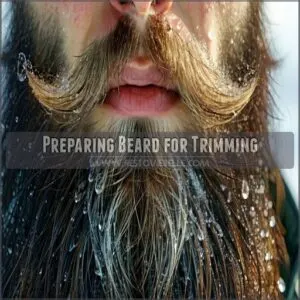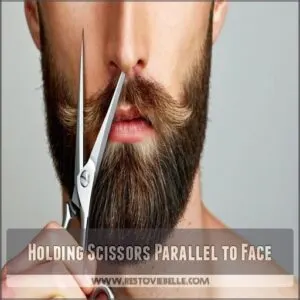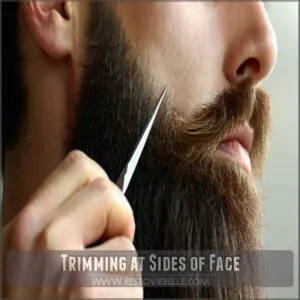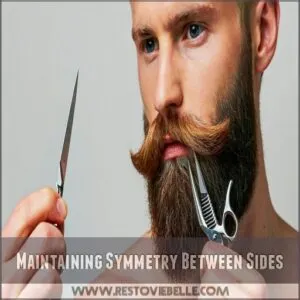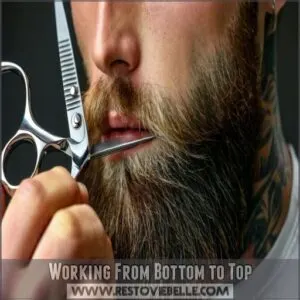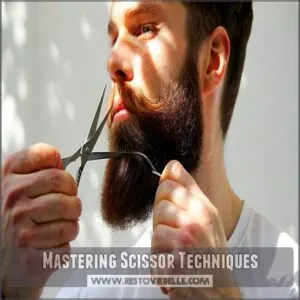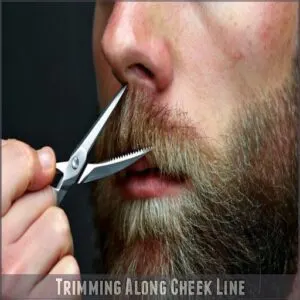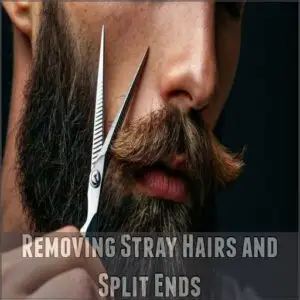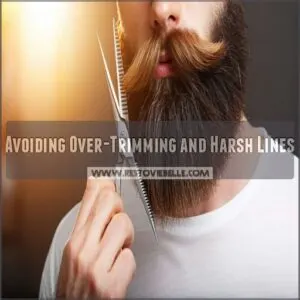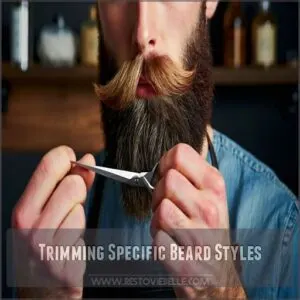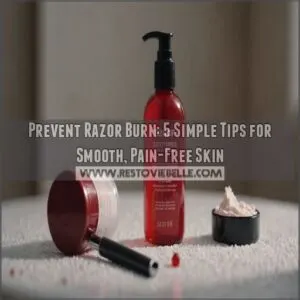This site is supported by our readers. We may earn a commission, at no cost to you, if you purchase through links.
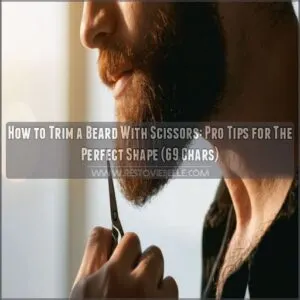 Trimming your beard with scissors is all about precision and patience. Start by washing and drying your beard—clean hair makes for clean cuts. Use a fine-toothed comb to align the hairs, then grab sharp, high-quality beard scissors.
Trimming your beard with scissors is all about precision and patience. Start by washing and drying your beard—clean hair makes for clean cuts. Use a fine-toothed comb to align the hairs, then grab sharp, high-quality beard scissors.
Hold the scissors parallel to your face and trim small sections, following your beard’s natural shape. Work symmetrically, regularly checking the mirror to keep things even. Pay special attention to the neckline, jawline, and mustache—precision here can make or break the look.
And remember, less is more; over-trimming is a slippery slope. A touch of beard oil afterward brings everything together perfectly.
Table Of Contents
- Key Takeaways
- Preparing Beard for Trimming
- Trimming Beard With Scissors
- Mastering Scissor Techniques
- Refining Beard Edges
- Trimming Specific Beard Styles
- Post-Trim Care and Maintenance
- Frequently Asked Questions (FAQs)
- How to trim your beard and neck for a short boxed beard?
- Are beard trimming scissors the same as regular scissors?
- What are the best scissors for a beard & mustache?
- Is it OK to trim beard with scissors?
- How do you trim a beard for beginners?
- How to trim a beard without a trimmer?
- Do you trim your beard wet or dry?
- Can you trim a beard with just scissors?
- Are scissors good for beard?
- How to trim a beard with scissors?
- Conclusion
Key Takeaways
- Start with a clean, dry beard and comb it to detangle and align the hairs for precise trimming.
- Use sharp, high-quality scissors and trim small sections, holding them parallel to your face to maintain symmetry and avoid over-trimming.
- Focus on defining key areas like the neckline, jawline, and mustache while checking symmetry frequently in a mirror.
- Finish with beard oil or balm to nourish hair, tame flyaways, and give your beard a polished, professional look.
Preparing Beard for Trimming
You’ll need to start with a clean, dry beard that’s free from tangles to achieve professional-looking results with your scissors.
Before you grab those shears, take a few minutes to wash your beard with mild shampoo, pat it dry with a clean towel, and run a fine-toothed comb through it to align the hairs in their natural direction.
Washing and Drying The Beard
Proper beard hygiene starts with lukewarm water and gentle shampoo to avoid stripping natural oils. After washing away dirt and product buildup, pat your beard dry with soft towels rather than rubbing, which can damage the hair.
Let your beard air dry completely for the most accurate trim. To achieve the perfect shape, consider visiting a beard trimming guide for expert advice.
While waiting, apply a light beard conditioning treatment to maintain softness and make trimming easier.
Detangling and Aligning Hairs
Now that your beard’s clean, let’s tackle those hair tangles. Begin with a quality beard oil to soften stubborn knots. Your detangling tools will make or break your trimming success.
For more on beard detangling, consider the various techniques available.
- Start with a wide-toothed comb for initial tangle removal
- Use gentle, downward strokes for beard combing
- Apply additional oil to really tough knots
- Switch to a fine-toothed comb for final hair alignment
Remember, patience beats force when detangling your beard.
Assessing Beard Shape and Length
Understanding your facial structure and growth patterns shapes your entire beard journey.
Stand before a three-way mirror to analyze your hair texture and natural beard shape.
Map your growth direction – it’ll guide your trimming strategy.
To achieve a well-groomed look, investing in a beard scissors kit is essential for precise trimming.
| Face Type | Growth Pattern | Recommended Style |
|---|---|---|
| Oval | Even | Balanced length |
| Square | Dense | Shorter sides |
| Round | Mixed | Longer bottom |
Take time to assess your beard symmetry and mark your target length ratios before picking up those trim beard scissors.
Trimming Beard With Scissors
You’ll find that using scissors gives you the most control over your beard’s shape and length, making it easier to achieve that perfect, professional look you’re after.
By learning the right scissor techniques, you can transform your morning grooming routine from a rushed trim into a precise craft that’ll have people wondering if you’ve got a personal barber on call.
Holding Scissors Parallel to Face
With your beard prepped, let’s nail the scissor angle for a flawless trim. Hold your beard scissors parallel to your face, not pointing inward or outward. This position prevents trimming errors and maintains natural beard symmetry. Using the right Beard Trimming tools is essential for achieving a professional look.
When it comes to proper facial alignment while trimming:
- Keep your head straight and chin level
- Position the scissors at a 0-degree angle
- Maintain consistent pressure throughout the cut
Trimming at Sides of Face
Start by combing your facial hair to detangle and align it naturally.
While holding your beard scissors parallel to your face, trim small sections along the sides to refine your beard lines.
Using the right beard trimming tools is essential for achieving a neat look.
Use a mirror for better precision, and focus on incremental cutting to avoid trimming errors.
Periodically check for symmetry—this attention guarantees a balanced, polished side trimming.
Maintaining Symmetry Between Sides
Achieving beard balance starts with checking side alignment often.
Trim beard scissors in hand, aim for facial harmony by snipping evenly on both sides.
Use a mirror to check symmetry tips from different angles, avoiding trimming errors.
To guarantee the best results, consider investing in high quality scissors that offer precision and control.
Work gradually, cutting small sections, and keep focused on maintaining even lengths.
Scissors for beards demand patience for flawless symmetry.
Working From Bottom to Top
Work your way upward for a precision scissor trim technique.
Begin bottom trimming the beard, creating even beard layers as you ascend.
Focus on trimming angles that match your face shape while respecting your hair texture.
Use light, controlled cuts—small sections at a time.
Trust quality scissors for beards to avoid mistakes.
These beard trimming tips guarantee a polished, natural look!
Mastering Scissor Techniques
Mastering scissor techniques is all about control and precision to get the perfect shape. With steady hands and the right approach, you’ll trim like a pro in no time.
Trimming Sides With Scissors
Getting the sides right sets the tone for the trim.
Follow these steps:
- Comb it out: Even out the hair with a fine comb.
- Scissor angles matter: Hold scissors parallel to your face for precision.
- Trim lightly: Snip small sections to avoid trimming errors.
- Check symmetry: Use mirrors to balance both sides perfectly.
Handling Chin and Neck Areas
For a sharp look, define your neckline by placing fingers above your Adam’s apple—a natural guide.
Use the trim beard scissors for stray hairs along the chin and neck, matching facial contours.
Trim Beard Borders confidently without overdoing it.
Avoid Skin Irritation by keeping cuts clean.
Here’s a quick guide:
| Focus Area | Action |
|---|---|
| Chin Definition | Trim evenly to match contours. |
| Neck Shaping | Define clean edges. |
| Beard Borders | Remove stray hairs. |
| Facial Contours | Follow natural lines. |
| Skin Irritation | Avoid harsh trims. |
To maintain a neat appearance, consider the overall Facial Contours when trimming.
Trimming Mustache With Scissors
After tackling the chin and neck, focus your scissor skills on your mustache.
Comb your mustache hairs straight down.
Trim any hairs that hang over your lip, using short, controlled snips.
For a neat look, use your scissors to carefully shape the bottom edge of your mustache.
This beard trimming technique enhances your overall beard shaping and facial hair care.
Remember, patience is key to mastering these scissor techniques and achieving a stylish mens style.
Checking Symmetry and Making Adjustments
You’ve tackled the mustache, but let’s fine-tune the whole look.
Checking symmetry confirms facial balance and avoids trimming errors.
Use these adjustment techniques:
- Hold a mirror at different angles for symmetry checks.
- Comb through and compare beard alignment on both sides.
- Snip uneven sections using your beard scissors technique.
- Step back often—your eyes can miss details up close.
Refining Beard Edges
Refining your beard’s edges is all about creating clean, sharp lines that highlight your natural shape.
Focus on trimming along the cheek line, neckline, and jawline for a polished, professional look.
Trimming Along Cheek Line
To master cheek line trimming, use a comb to lift facial hair and a steady hand to guide beard scissors.
Follow your hair’s natural texture for a sharp, clean shape.
Avoid trimming errors by snipping conservatively and checking symmetry in a mirror.
This beard scissors guide guarantees precise shaping without overdoing it—a key step in effective beard trimming techniques.
Defining Jawline and Neckline
Nailing the perfect jawline and neckline boosts any beard’s look. For Jawline Shaping, imagine a line from the ear’s tragus to the mouth’s corner.
Neckline Refining? Shave two fingers above your Adam’s apple, creating clean Beard Borders that match Facial Contours. Understanding beard neckline techniques is essential for achieving a polished look.
Use a trimmer for precision, avoiding overly high lines. Consistency keeps beard care sharp.
Removing Stray Hairs and Split Ends
Stray hairs and split ends can ruin an otherwise polished beard.
Use these steps for precise scissors trimming:
- Comb thoroughly to spot stray hairs and uneven ends.
- Use small snips and follow the natural shape to maintain control.
- Check symmetry regularly with mirrors to confirm an even look.
- Remove split ends gently to prevent damage, enhancing overall beard health.
Avoiding Over-Trimming and Harsh Lines
Over-trimming can turn a bold look into a patchy disaster.
Use small snips, stay patient, and check your progress often.
Keep the beard edges natural—sharp, harsh lines look less flattering.
A quality beard trimming guide helps maintain balance, while the scissor trim technique gives you precision.
Remember, less can be more when you trim with scissors.
Master control, not speed.
Trimming Specific Beard Styles
Each beard style requires a slightly different approach to trimming for the best results.
With the right technique and scissors in hand, you can shape anything from a patchy beard to a bold goatee like a pro.
Trimming Patchy Beard With Scissors
Patchy beards demand precision and patience. A scissor trim technique can fix those sparse areas while maintaining your beard’s natural charm.
Here’s how:
- Trim stray hairs with sharp scissors to create an even look.
- Focus on defining lines, not shaving it all off.
- Blend patches using a comb for guidance.
- Use beard oil to soften and shape.
Trimming Short Beard With Scissors
Short beards need precision. Start with clean, dry facial hair. Comb it to align the beard texture and identify uneven spots.
Use scissors parallel to your face and trim your beard in small, controlled snips. Focus on the sides and work in the direction of the chin.
Check symmetry often to catch trimming errors. Scissor tips guarantee natural Beard Length without overdoing it.
Trimming Long Beard With Scissors
Tackling a long beard? Start by combing it to separate and align the hairs.
Use quality beard scissors for precision, snipping stray ends incrementally.
Work from the bottom up to maintain beard length and control.
Trim your beard in sections, constantly checking symmetry.
These trimming tips will help you shape and style with confidence for endless styling options!
Trimming Goatee or Other Styles
Shaping a goatee or specific beard styles takes steady hands and solid beard shaping tips.
Use beard scissors to trim precisely around the chin and jawline, keeping symmetry in focus.
A beard trimmer with a razor trimmer works well for clean edges.
Comb through as you trim your beard, and avoid over-snipping—small corrections guarantee a refined final look.
Post-Trim Care and Maintenance
Keep your beard healthy and sharp by following a simple post-trim routine. Use beard oil to soften and moisturize, and regularly trim stray hairs to maintain a clean look.
Applying Beard Oil or Balm
Post-trim care locks in the results.
Use beard oil for skin moisture and hair nourishment—it softens your beard and relieves irritation.
Beard balm adds control and tame hold.
Here’s how to apply these products:
- Apply oil on a clean, dry beard.
- Work balm evenly with your palms.
- Comb for uniform distribution.
- Brush to shape your style effortlessly.
Addressing Split Ends and Stray Hairs
Split ends and stray hairs can ruin your beard-shaping efforts, so don’t skip this step.
Gently comb through and snip damaged hairs with sharp scissors for a sleek finish.
Target small sections for better control.
Refine as needed and keep it even.
It’s the small details that push your beard trimming skills to pro level.
| Issue | Solution |
|---|---|
| Split ends | Use sharp scissors to trim |
| Stray hairs | Comb and snip carefully |
| Uneven texture | Work in small sections |
| Messy appearance | Check for symmetry |
| Over-trimming risk | Trim slowly and precisely |
The key to a well-groomed beard is attention to detail.
Check for symmetry and trim slowly and precisely to avoid over-trimming.
Work in small sections to maintain even texture and check for stray hairs to snip carefully.
Use sharp scissors to trim split ends and refine as needed.
Target small sections for better control and keep it even.
It’s the small details that push your beard trimming skills to pro level.
Avoiding Rushing and Using Dull Scissors
Patience is key for safe trimming with scissors. Avoid rushing the process; a hurried trim invites mistakes. Dull blades snag and pull, leading to uneven results and potential harm.
Understanding the importance of hair trimming techniques can also improve your overall grooming skills.
- Invest in scissor sharpening for clean cuts.
- Control your trimming pace – slow and steady wins the race.
- Practice beard patience; it’s a marathon, not a sprint. A sharp blade and careful trimming with scissors guarantees a well-groomed beard.
Maintaining Healthy Beard With Regular Trimming
Your beard’s health hinges on regular trims. Snip away split ends and stray hairs to prevent breakage and promote even growth.
Use quality trimming tools, like sharp scissors, for precision. Apply beard oil after trimming to soften hair and soothe skin.
Routine beard maintenance, paired with proper trimming techniques, defines beard styles and keeps your look polished. Trim your beard regularly!
Frequently Asked Questions (FAQs)
How to trim your beard and neck for a short boxed beard?
Think of your beard like a sculpture—start by lining up the cheeks and neck with precision.
Use scissors to snip stray hairs, trim evenly, and define edges carefully for that sharp short-boxed look.
Are beard trimming scissors the same as regular scissors?
Beard trimming scissors aren’t the same as regular scissors.
They’re smaller, sharper, and designed for precision, making it easier to shape your beard neatly without causing split ends or uneven cuts.
It’s worth investing.
What are the best scissors for a beard & mustache?
Not all scissors are created equal—go for professional beard or mustache scissors with sharp, stainless steel blades and a small, ergonomic design.
Look for adjustable tension screws and rounded tips for precision and safety.
Is it OK to trim beard with scissors?
Using scissors to trim your beard is perfectly fine and offers precision and control.
Stick to sharp, professional-grade scissors, take your time, and trim dry hair for even results.
Patience guarantees a clean, polished appearance.
How do you trim a beard for beginners?
Start by washing and drying your beard completely.
Use sharp scissors and a comb, snipping small sections evenly.
Trim slowly, checking symmetry often.
Focus on stray hairs, shape carefully, and finish with beard oil for smoothness.
How to trim a beard without a trimmer?
Imagine sculpting marble with precision instead of hacking with a dull tool.
Comb your beard, snip stray hairs incrementally with sharp scissors, and check symmetry in good lighting.
Patience guarantees a clean, stylish appearance.
Do you trim your beard wet or dry?
Always trim your beard dry.
Wet hair stretches and looks longer, leading to uneven results once it dries.
A clean, dry beard guarantees precision, so you don’t end up accidentally snipping more than you intended.
Can you trim a beard with just scissors?
Yes, you can trim a beard with just scissors, but it takes patience and precision.
Use fine-toothed combs as guides, snip small sections gradually, and maintain steady hands for a controlled, even, and professional result.
Are scissors good for beard?
Scissors are fantastic for precise beard trims! They give you complete control, letting you snip stray hairs and sculpt your style with accuracy.
Plus, they’re gentler than clippers, especially for longer beards or detailed shaping.
How to trim a beard with scissors?
Start by washing and drying your beard, then comb it to remove tangles.
Trim small, even sections using sharp scissors, holding a comb as a guide.
Work slowly, checking symmetry, and finish with beard oil.
Conclusion
Mastering how to trim a beard with scissors is about precision, patience, and practice.
Start with clean, detangled hairs, and trim slowly, keeping symmetry between sides.
Focus on the neckline, jawline, and mustache to define your style, and remember, less is more when trimming.
Sharp tools and small, measured cuts will give you control and a polished look.
Finish with beard oil for softness and shine.
Stick with these tips, and your beard will stay sharp and on point.
- https://healthcare.utah.edu/healthfeed/postings/2015/04/042215_cvarticle-beard-health.php
- https://www.yalemedicine.org/news/beard-mustache-skin-problems
- https://news.mit.edu/2020/why-shaving-dulls-razors-0806
- https://www.groomingwise.com/trim-a-beard-with-scissors/
- https://thebeardclub.com/blogs/beard-culture/how-to-trim-beard-with-scissors
